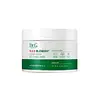What's inside
What's inside
 Key Ingredients
Key Ingredients

 Benefits
Benefits

 Concerns
Concerns

 Ingredients Side-by-side
Ingredients Side-by-side

Centella Asiatica Extract
CleansingDipropylene Glycol
HumectantGlycerin
HumectantHouttuynia Cordata Extract
Skin ConditioningAloe Ferox Leaf Extract
Skin ConditioningWater
Skin Conditioning1,2-Hexanediol
Skin ConditioningAllantoin
Skin ConditioningHexylene Glycol
EmulsifyingHydroxyacetophenone
AntioxidantXanthan Gum
EmulsifyingCarbomer
Emulsion StabilisingArginine
MaskingDipotassium Glycyrrhizate
HumectantDisodium EDTA
Aloe Barbadensis Leaf Extract
EmollientDioscorea Japonica Root Extract
Skin ConditioningUlmus Davidiana Root Extract
Skin ConditioningViola Mandshurica Flower Extract
AntioxidantLaminaria Japonica Extract
Skin ProtectingButylene Glycol
HumectantSodium Hyaluronate
HumectantHydrogenated Phosphatidylcholine
EmulsifyingCaprylic/Capric Triglyceride
MaskingSucrose Stearate
EmollientCetearyl Alcohol
EmollientAsiaticoside
AntioxidantAsiatic Acid
Skin ConditioningMadecassic Acid
Skin ConditioningMadecassoside
AntioxidantCentella Asiatica Extract, Dipropylene Glycol, Glycerin, Houttuynia Cordata Extract, Aloe Ferox Leaf Extract, Water, 1,2-Hexanediol, Allantoin, Hexylene Glycol, Hydroxyacetophenone, Xanthan Gum, Carbomer, Arginine, Dipotassium Glycyrrhizate, Disodium EDTA, Aloe Barbadensis Leaf Extract, Dioscorea Japonica Root Extract, Ulmus Davidiana Root Extract, Viola Mandshurica Flower Extract, Laminaria Japonica Extract, Butylene Glycol, Sodium Hyaluronate, Hydrogenated Phosphatidylcholine, Caprylic/Capric Triglyceride, Sucrose Stearate, Cetearyl Alcohol, Asiaticoside, Asiatic Acid, Madecassic Acid, Madecassoside
Glycyrrhiza Uralensis Root Extract
Skin ConditioningButylene Glycol
HumectantGlycerin
Humectant1,2-Hexanediol
Skin ConditioningAllantoin
Skin ConditioningPanthenol
Skin ConditioningArginine
MaskingPolyglyceryl-10 Laurate
Skin ConditioningPolyglyceryl-10 Myristate
Skin ConditioningHydrolyzed Sodium Hyaluronate
Skin ConditioningEctoin
Skin ConditioningGlycyrrhizic Acid
HumectantLactobionic Acid
BufferingAsiaticoside
AntioxidantAsiatic Acid
Skin ConditioningMadecassic Acid
Skin ConditioningPrunus Armeniaca Kernel Oil
MaskingMadecassoside
AntioxidantPogostemon Cablin Leaf Oil
MaskingJuniperus Communis Fruit Oil
MaskingAmyris Balsamifera Bark Oil
MaskingCitrus Nobilis Peel Oil
MaskingCitrus Paradisi Peel Oil
MaskingBetaine Salicylate
AntimicrobialPiper Nigrum Fruit Oil
MaskingVetiveria Zizanoides Root Oil
MaskingGlycyrrhiza Uralensis Root Extract, Butylene Glycol, Glycerin, 1,2-Hexanediol, Allantoin, Panthenol, Arginine, Polyglyceryl-10 Laurate, Polyglyceryl-10 Myristate, Hydrolyzed Sodium Hyaluronate, Ectoin, Glycyrrhizic Acid, Lactobionic Acid, Asiaticoside, Asiatic Acid, Madecassic Acid, Prunus Armeniaca Kernel Oil, Madecassoside, Pogostemon Cablin Leaf Oil, Juniperus Communis Fruit Oil, Amyris Balsamifera Bark Oil, Citrus Nobilis Peel Oil, Citrus Paradisi Peel Oil, Betaine Salicylate, Piper Nigrum Fruit Oil, Vetiveria Zizanoides Root Oil
Ingredients Explained
These ingredients are found in both products.
Ingredients higher up in an ingredient list are typically present in a larger amount.
1,2-Hexanediol is a synthetic liquid and another multi-functional powerhouse.
It is a:
- Humectant, drawing moisture into the skin
- Emollient, helping to soften skin
- Solvent, dispersing and stabilizing formulas
- Preservative booster, enhancing the antimicrobial activity of other preservatives
Allantoin is a soothing ingredient known for its protective and moisturizingg properties. Because of this, it is often added to products with strong active ingredients.
Studies show higher concentrations of this ingredient can promote wound healing.
Though it can be derived from the comfrey plant, allantoin is produced synthetically for cosmetic products to ensure purity.
Learn more about AllantoinArginine is an amino acid that is important for human development. Your body uses is it to produce hair keratin and skin collagen.
As a cosmetic ingredient, Arginine has antioxidant properties and can also help repair damaged skin. This ingredient is derived either synthetically or from animals.
Arginine isn't fungal acne safe when used in the presence of other lipids (fats, fatty acids, oils, esters, etc). Oils and fats occur naturally within the skin, so take caution when using Arginine if you're prone to fungal acne.
Learn more about ArginineAsiatic Acid is a major component of Centella Asiatica Extract. It has wound-healing, anti-inflammatory, and antioxidant properties.
Studies show Asiatic Acid is able to block the pathway for skin inflammation receptors, helping to soothe skin.
As an antioxidant, asiatic acid helps protect our skin against damaging environmental factors.
Learn more about Asiatic AcidAsiaticoside comes from the super popular skin-soothing ingredient, Centella asiatica. It is one of four active compounds found in the extract of Centella Asiatica.
Asiaticoside is an antioxidant and helps with wound healing. It has been shown to increase antioxidant activity during the wound healing process.
Butylene Glycol (or BG) is used within cosmetic products for a few different reasons:
Overall, Butylene Glycol is a safe and well-rounded ingredient that works well with other ingredients.
Though this ingredient works well with most skin types, some people with sensitive skin may experience a reaction such as allergic rashes, closed comedones, or itchiness.
Learn more about Butylene GlycolGlycerin is already naturally found in your skin. It helps moisturize and protect your skin.
A study from 2016 found glycerin to be more effective as a humectant than AHAs and hyaluronic acid.
As a humectant, it helps the skin stay hydrated by pulling moisture to your skin. The low molecular weight of glycerin allows it to pull moisture into the deeper layers of your skin.
Hydrated skin improves your skin barrier; Your skin barrier helps protect against irritants and bacteria.
Glycerin has also been found to have antimicrobial and antiviral properties. Due to these properties, glycerin is often used in wound and burn treatments.
In cosmetics, glycerin is usually derived from plants such as soybean or palm. However, it can also be sourced from animals, such as tallow or animal fat.
This ingredient is organic, colorless, odorless, and non-toxic.
Glycerin is the name for this ingredient in American English. British English uses Glycerol/Glycerine.
Learn more about GlycerinMadecassic Acid is a major component of Centella Asiatica Extract. It has anti-inflammatory and antioxidant properties.
It is a triterpenoid, meaning it naturally acts as an antioxidant. Antioxidants protect your skin against damage from environmental factors such as pollution and UV.
Studies show Madecassic Acid helps soothe the skin due to its ability to block inflammation pathways.
Learn more about Madecassic AcidMadecassoside comes from the super popular skin-soothing ingredient, Centella asiatica. It is one of four active compounds found in the extract of Centella Asiatica.
Madecassoside has antioxidant, anti-inflammatory, and hydrating properties. It contains fatty acids, amino acids, beta-carotene, and phytochemicals.
One study found using Madecassoside with ascorbic acid helped reduce the signs of aging and improved skin hydration.
Learn more about Madecassoside